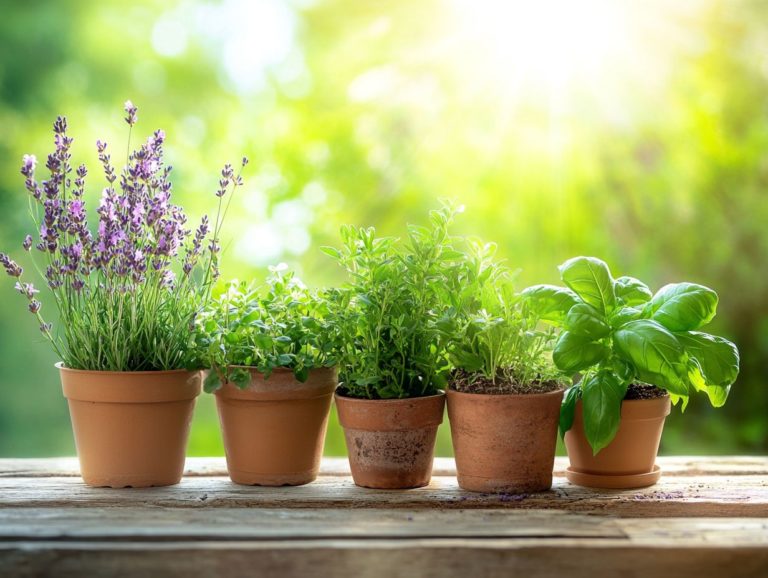What Are the Best Practices for Herbal Extraction?
Herbal extraction is an intriguing process that harnesses the remarkable power of plants to produce effective remedies and products.
This exploration delves into a range of extraction methods, spanning traditional techniques to modern innovations. Grasping the key factors that affect extraction quality is crucial for achieving the best possible outcomes.
It s important to recognize common pitfalls to avoid while also appreciating the diverse applications of herbal extracts across various industries. Whether you re just starting your journey or are a seasoned herbalist, you ll discover amazing insights that are invaluable for everyone involved.
Contents
- Key Takeaways:
- Methods of Herbal Extraction
- Factors Affecting Herbal Extraction
- Best Practices for Herbal Extraction
- Top Mistakes to Avoid in Herbal Extraction!
- Applications of Herbal Extraction
- Frequently Asked Questions
- What Are the Best Practices for Herbal Extraction?
- What factors should be considered when choosing the best method for herbal extraction?
- What are some common methods used for herbal extraction?
- What are the benefits of using organic solvents for herbal extraction?
- What are the risks associated with herbal extraction?
- How can I ensure the quality and consistency of herbal extracts?
- Are there any safety precautions to take when handling herbal extracts?
Key Takeaways:

- Proper selection of the extraction method is crucial for obtaining high-quality and potent herbal extracts.
- Factors such as plant material, solvent, and extraction conditions greatly impact the efficiency of herbal extraction.
- Following best practices like proper plant material preparation, solvent selection, and extraction time can ensure successful and safe herbal extraction for various industries and applications.
What is Herbal Extraction?
Herbal extraction stands as a cornerstone in the world of natural medicine, designed specifically to extract beneficial substances from plant materials and unlock their medicinal benefits. This intricate process involves extracting essential oils, flavonoids, and other active ingredients that are vital for creating herbal extracts and natural products that enhance health.
A variety of extraction techniques are utilized to optimize yield and efficiency, ensuring that the beneficial properties of the herbs remain intact.
The importance of this process is profound, serving as the foundation for developing effective remedies and supplements that nourish the body and promote overall wellness. Among the various extraction methods, you ll find maceration, steam distillation, and solvent extraction, each uniquely suited to capture specific compounds.
For example, steam distillation is frequently used to harvest essential oils, while ethanol extraction shines in producing potent tinctures rich in flavonoids.
These diverse extracts offer a myriad of therapeutic benefits, from alleviating inflammation to boosting immunity, showcasing the incredible versatility and richness of herbal medicine.
Methods of Herbal Extraction
The methods of herbal extraction encompass a range of techniques that have evolved through the ages, combining age-old traditions with contemporary advancements aimed at optimizing extraction efficiency and yield from plant materials.
You ll encounter techniques like solvent extraction, supercritical fluid extraction, ultrasound-assisted extraction, and microwave-assisted extraction, each presenting its unique advantages.
These methods allow for the precise isolation of essential oils, flavonoids, and other bioactive compounds that underpin the effectiveness of herbal extracts. For more information, you can explore best practices for herbal remedy use.
Overview of Different Techniques
An overview of the various techniques used in herbal extraction unveils a rich tapestry of methods, each designed to optimize the extraction of active ingredients while minimizing contaminants. You ll find that solvent extraction, a traditional approach, often employs solvents like ethanol, whereas supercritical fluid extraction is a method that uses high pressure and temperature to extract substances efficiently.
Modern analytical techniques, such as high-performance liquid chromatography and gas chromatography, are critical for evaluating the extraction process and ensuring the purity of herbal extracts.
These methods differ significantly in terms of efficiency and duration. For instance, while solvent extraction might stretch over hours or even days, supercritical fluid extraction can deliver results in mere minutes, making it the go-to choice for those time-sensitive projects.
Ultrasound extraction uses sound waves to enhance the extraction rate, resulting in higher quality extracts with reduced residual solvents.
Each technique plays a crucial role depending on the specific compounds you are targeting, underscoring the importance of selecting the right method for achieving your desired outcome.
Factors Affecting Herbal Extraction
Several factors can profoundly influence herbal extraction. These factors directly impact both the efficiency and yield of the process.
You need to consider key variables such as the properties of the solvent, the amount of liquid compared to the plant material, the duration of extraction, and the existence of temperature-sensitive compounds.
Carefully optimizing these elements is essential to achieve maximum extraction efficiency. Grasping these influential variables is vital for crafting robust methods that produce high-quality herbal extracts, rich in active ingredients.
Influential Variables

The extraction yield hinges on several key variables that shape the effectiveness of your extraction process. Consider factors like extraction duration, the type of solvent you choose typically ethanol or other solvents and the specific properties of those solvents.
Each of these elements plays a critical role in determining the quality and quantity of bioactive compounds you can extract during the herbal processing.
Temperature and pressure conditions are particularly influential, as they directly affect the solubility of these compounds, ultimately impacting your overall yield. Don’t overlook the particle size of your plant material; finer particles often lead to more efficient extraction by increasing the surface area for the solvent to work its magic.
The presence of other phytochemicals can create interactions that influence the final composition of your extract. These interconnected variables not only define your yield but also determine the efficacy and stability of the herbal extracts.
Therefore, optimizing these conditions is essential for achieving your desired outcomes.
Best Practices for Herbal Extraction
Following best practices is crucial for achieving optimal results in herbal extraction. This includes selecting the appropriate extraction method, employing proper solvent extraction techniques, and meticulously controlling for contaminants to preserve the integrity of the herbal extracts.
By implementing these guidelines, you can significantly enhance the quality and efficacy of your final product.
Guidelines for Optimal Results
The guidelines for achieving optimal results in herbal extraction demand a meticulous approach to managing solvent properties and extraction duration. It also requires thorough analytical evaluation of the final products.
By carefully selecting solvents that align with your desired extraction yield and employing techniques like high-performance liquid chromatography (a technique used to assess the quality of your extracts) for quality assessment, you can significantly enhance the efficacy of your herbal extracts. However, it’s crucial to follow safety protocols for herbal extraction and dosage to ensure a safe process.
Moreover, it’s essential to monitor temperature and pressure throughout the extraction process, as these factors can greatly influence the solubilization of active compounds. Implementing a standard operating procedure (SOP) will help you maintain consistency across multiple batches.
Additionally, consider the type of plant material you re using, as its cellular structure could impact extraction efficiency. Regularly testing samples during the process allows you to track extraction progress and ensure that optimal concentrations of beneficial compounds are attained, ultimately leading to high-quality products.
Top Mistakes to Avoid in Herbal Extraction!
In the world of herbal extraction, avoiding common mistakes can significantly enhance your extraction results. It’s crucial to steer clear of missteps that can lead to significant pitfalls, undermining both the quality and efficiency of your extraction process.
You might find yourself facing issues like improper solvent selection, insufficient extraction duration, or neglecting the properties of temperature-sensitive compounds. Each of these oversights can adversely impact the integrity of the final product, so it s essential to approach the process with careful consideration and precision.
Avoiding Pitfalls and Errors
Avoiding pitfalls and errors in the extraction process is essential for high-quality herbal extracts. These extracts should contain the desired active ingredients.
By implementing careful procedures, you can eliminate contaminants and monitor extraction yield. This significantly enhances the effectiveness of your herbal processing.
To achieve this, it’s crucial to begin with top-notch raw materials, as the purity and potency of herbal ingredients form the backbone of successful extractions. Utilize appropriate solvents tailored to the specific compounds you wish to extract, while being mindful of temperature and time factors that can dramatically influence the outcome. For a deeper understanding, explore herbal preparations: extracting the essence.
Regularly calibrate your equipment and strictly adhere to guidelines to prevent any potential loss of quality of the extracts. Implement rigorous quality control measures to ensure your final product is effective and safe.
Applications of Herbal Extraction
Herbal extraction opens doors to countless exciting applications across many industries, profoundly influencing areas like natural medicine, drug development, and the creation of botanical extracts celebrated for their health benefits.
The versatility of these extracted compounds enables their seamless integration into medicines, health supplements, and beauty products, underscoring the essential role herbal extracts play in contemporary health and wellness.
Industries and Uses
Herbal extraction plays a pivotal role across various industries, especially in natural medicine and drug development, where herbal extracts are harnessed for their remarkable therapeutic properties. Through meticulous study of plant chemicals, researchers unveil the potential of essential oils and other bioactive compounds, opening new applications in healthcare and wellness products.
In the cosmetic realm, herbal extracts are prized for their skin-nourishing qualities. Ingredients like aloe vera and chamomile have become critical staples in beauty routines.
Meanwhile, the food industry leverages natural flavorings derived from herbs, enhancing not just taste but also overall health benefits, as many extracts are rich in antioxidants and anti-inflammatory properties.
The supplement market flourishes on the power of herbal extraction, with potent extracts from plants like turmeric and ginseng supporting metabolic and cognitive functions. By embracing the power of nature, various sectors ensure that consumers have access to safer, more effective alternatives.
Frequently Asked Questions
What Are the Best Practices for Herbal Extraction?
Herbal extraction is the process of obtaining a plant’s beneficial compounds in concentrated form. Wondering about the best practices for herbal extraction? Here are the top strategies:
What factors should be considered when choosing the best method for herbal extraction?
The type of plant, its active compounds, and the desired end product should be taken into account when selecting the best extraction method. It is essential to choose a method that will preserve the plant’s beneficial properties and produce a high-quality extract.
What are some common methods used for herbal extraction?
The most common methods for herbal extraction include maceration, decoction, infusion, steam distillation, and solvent extraction. Each method has its advantages and is suitable for different types of plants and compounds.
What are the benefits of using organic solvents for herbal extraction?
Organic solvents, such as ethanol and carbon dioxide, are widely used in herbal extraction due to their ability to extract a wide range of compounds effectively. They are also environmentally friendly and safe for consumption.
What are the risks associated with herbal extraction?
Herbal extraction carries some risks. These include contamination from pesticides or heavy metals and the wrong identification of plants.
Improper storage can lead to loss of potency or spoilage. Follow proper protocols and quality control measures to reduce these risks.
How can I ensure the quality and consistency of herbal extracts?
To ensure quality, source high-quality plant material. Stick to strict extraction protocols and test the final product carefully.
Regular monitoring and proper storage are vital to maintain the integrity of the extract.
Are there any safety precautions to take when handling herbal extracts?
Yes, always handle herbal extracts with care! They are potent and can cause adverse reactions if consumed in large amounts.
Follow proper labeling and storage guidelines to prevent accidental ingestion.








